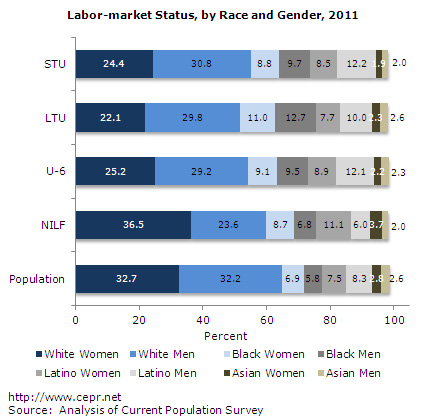March 07, 2012
In a new report out yesterday, we examine the demographics — gender, race, and age — of long-term hardship in the labor market. The report follows up on a paper (pdf) we did in January that made the case for looking beyond the standard “long-term unemployment” measure, to include the “discouraged,” the “marginally attached,” and the involuntarily part-time.
The new paper describes the people who are currently experiencing long-term hardship. While the economic recovery is on track for some, others are being left further behind. This chart, for example, shows the race and gender breakdown of the short-term unemployed (STU), the long-term unemployed (LTU), the unemployed and underemployed using the Bureau of Labor Statistics “U-6? measure, and those not in the labor force (NILF).

Our main conclusion, from the paper:
…by whichever measure –the standard long-term unemployment rate or an expanded “long-term hardship” measure…– the data … show that the burden of long-term joblessness is borne unevenly. Blacks and Latinos, less-educated workers, and younger workers are all much more likely to be unemployed, long-term unemployed, “discouraged,” “marginally attached,” or involuntarily part-time, with terrible consequences for these groups’ current and future economic, social, and health outcomes.







